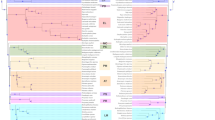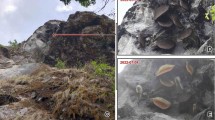Abstract
Dominating global arid environments, from desert to coastal dunes, most Tenebrionidae are highly specific in their habitat preferences and display limited dispersal potential, thus exhibiting a remarkable degree of regional genetic and morphological differentiation. The tenebrionid genus Phaleria is speciose and widely distributed, with P. acuminata and P. bimaculata having a wide Mediterranean distribution, with numerous morphological differentiations at population level, often described as different taxa of doubtful taxonomical significance. In order to investigate the variability of the central Mediterranean populations of P. bimaculata and P. acuminata and to compare the results obtained with different identification techniques, these species were sampled on sandy beaches in Sicily (southern Italy) and on circum-Sicilian and Maltese islands. Collected samples were studied through the application of geometric morphometrics and the sequencing of a fragment of the mitochondrial COII gene. Geometric morphometrics and molecular analyses gave congruent results, allowing a sound separation of the two species. At the population level, the two species showed different patterns. P. acuminata showed a remarkable morphological and molecular homogeneity throughout the sampled area. Conversely, two well-characterized sub-clades were detected within P. bimaculata, and within the two lineages, a low-to-absent inter-populations differentiation was observed, in spite of the physical isolation of the sampled sandy beaches and of their geographical distance. These two P. bimaculata lineages, hereby named “Tyrrhenian sub-clade” and “Southern sub-clade,” might be compatible with the hypothesis of subspecific status already proposed for the populations from the Aeolian archipelago (as P. bimaculata marcuzzii Aliquò).





Similar content being viewed by others
References
Adams DC, Rohlf FJ, Slice D (2004) Geometric morphometrics: ten years of progress following the ‘revolution’. Ital J Zool 71:5–16
Aliquò V(1993) Dati nuovi e riassuntivi sui coleotteri Tenebrionidi delle isole circumsiciliane (Coleoptera: Tenebrionidae). Naturalista sicil, Palermo 17:p 111–125
Aliquò V, Leo P (1997–1998) I coleotteri tenebrionidi della regione iblea (Sicilia sudorientale). Atti e Memorie dell’Ente Fauna Siciliana vol.V: 49–84
AliquòV Soldati F (2010) Coleotteri Tenebrionidi di Sicilia (Insecta: Coleoptera Tenebrionidae). Monografie Naturalistiche, 1. Edizioni Danaus, Palermo, p 176
Bookstein FL (1989) Principal warps: thin-plate splines and the decomposition of deformations. IEEE Trans Pattern Anal Mach Intell 11:567–585
Bookstein FL (1991) Morphometric tools for Landmark data: geometry and biology. Biology Cambridge University Press, Cambridge
Canzoneri S (1968) Materiali per una monografia delle Phaleria del sottogenere Phaleria Latr. Memorie della Società Entomologica Italiana 47:117–167
Canzoneri S (1970) I Tenebrionidi delle Isole Egadi. Boll Museo civ St nat Verona 18:55–89
ClarkinE Maggs CA, Arnott A, Briggs S, Houghton JDR (2012) The colonization of macroalgal rafts by the genus Idotea (sub-phylum Crustacea; order Isopoda): an active or passive process? J Mar Biol Ass UK 92:1273–1282
Colombini I, Chelazzi L, Fallaci M, Palesse L (1994) Zonation and surface activity of some Tenebrionid beetles living on a Mediterranean sandy beach. J Arid Environ 28:215–230
Contreras-Diaz HG, Moya O, Oromi P, Juan C (2003) Phylogeography of the endangered darkling beetle species of Pimelia endemic to Gran Canaria (Canary Islands). Mol Ecol 12:2131–2143
Dajoz R (1984) Tenebrionidae européens noveaux ou peu connus. Cahiers du Naturaliste 39:89–92
de Jong YSDM (ed) (2010) Fauna Europaea version 2.3. Web Service available online at http://www.faunaeur.org
Deidun A, Schembri PJ (2008) Assessing inter-beach differences in semi-terrestrial arthropod assemblages on Maltese pocket sandy beaches (Central Mediterranean). Mar Ecol 29:108–117
Deidun A, Azzopardi M, Saliba S, Schembri PJ (2003) Low faunal diversity on Maltese sandy beaches: fact or artefact? Est Coast Shelf Sci 58:83–92
Deidun A, Saliba S, Schembri PJ (2007) Banquette faunal assemblages from groomed and ungroomed beaches in the Maltese Islands. In: Proceedings of the CIESM 38th congress, Istanbul, p 456
Deidun A, Saliba S, Schembri PJ (2009) Considerations on the ecological role of wrack accumulations on sandy beaches in the Maltese Islands and recommendations for their conservation management. J Coast Res (SI). In: Proceedings of the 10th international coastal symposium, vol 56. Portugal, pp 410–414
Deidun A, Pawley A, Schembri PJ (2010) Distribution and biology of two sympatric Phaleria (Coleoptera: Tenebrionidae) species on Maltese sandy beaches. In: Proceedings of the 39th CIESM Congress, Venice, Italy, p. 737
Deidun A, Marrone F, Sparacio I, Arculeo M, Curatolo T, Sciberras A, Sciberras J, Lo Brutto S (2011) New morphological, morphometric and distribution data on Phaleria bimaculata (Linnaeus, 1767) (Coleoptera: Tenebrionidae) from the islands and archipelagos of the Central Mediterranean area. Bull Insect 64:215–222
Doyen JT, Matthews EG, Lawrence JF (1989) Classification and annotated checklist of the Australian genera of Tenebrionidae (Coleoptera). Invertebr Syst 3(3):229–260
Fallaci M, Colombini I, Palesse L, Chelazzi L (1997) Spatial and temporal strategies in relation to environmental constraints of four tenebrionids inhabiting a Mediterranean coastal dune system. J Arid Environ 37:45–64
Fattorini S (2002) A comparison of relict versus dynamic models for tenebrionid beetles (Coleoptera: Tenebrionidae) of Aegean Islands (Greece). Belgian J Zool 132:55–64
Fattorini S, Leo P (2000a) Levels of endemism in the Aegean tenebrionids (Coleoptera, Tenebrionidae). Biogeographia Lav Soc ital Biogeogr 21:429–440
Fattorini S, Leo P (2000b) Darkling beetles from Mediterranean minor islands: new records and biogeographical notes. Boll Soc Entom ital 132:205–217
Gardini G (1975) Materiali per lo studio dei Tenebrionidi dell’Arcipelago Toscano (Col. Heteromera). Lav Soc ital Biogeogr 5:637–723
Gauci M, Deidun A, Schembri PJ (2005) Faunistic diversity of Maltese pocket sandy and shingle beaches: are these of conservation value? Oceanologia 27:219–241
Guindon S, Dufayard JF, Lefort V, Anisimova M, Hordijk W, Gascuel O (2010) New algorithms and methods to estimate maximum-likelihood phylogenies: assessing the performance of phyml 3.0. Syst Bio 59:307–21
Huelsenbeck JE, Ronquist F (2001) MrBayes: BAYESIAN inference of phylogeny. Biometrics 17:754–755
Klingenberg CP (2011) MORPHOJ: an integrated software package for geometric Morphometrics. Mol Ecol Resour 11:353–357
Lo Brutto S, Arculeo M, Grant WS (2011) Climate change and population genetic structure of marine species. Chem Ecol 27:107–119
Löbl I, Smetana A (eds) (2008) Catalogue of Palaearctic Coleoptera, vol 5. Tenebrionoidea. Apollo Books, Stenstrup, p 669
Malanotte-Rizzoli P, Manca BB, D’Alcala MR, Theocharis A, Bergamasco A, Bregant D, Budillon G, Civitarese G, Georgopoulos D, Michelato A, Sansone E, Scarazzato P, Souvermezoglou E (1997) A synthesis of the Ionian hydrography, circulation and water mass pathways during POEM-phase I. Progr Oceanogr 39:153–204
Marcuzzi G (1996) Il melanismo nel genere Phaleria Latreille (Insecta, Coleoptera, Tenebrionidae). Bollettino della Accademia Gioenia di Scienze naturali, Catania 351:9–13
Marrone F, Lo Brutto S, Arculeo M (2011) Cryptic invasion in Southern Europe: the case of Ferrissia fragilis (Pulmonata: Ancylidae) Mediterranean populations. Biologia 66:484–490
Mifsud D, Scupola A (1998) The Tenebrionidae (Coleoptera) of the Maltese Islands (Central Mediterranean). Annali del Museo Civico di Storia Naturale “G. Doria” 9:191–229
Millot C (1999) Circulation in the Western Mediterranean Sea. J Mar Syst 20:423–442
Minelli A, Chemini C, Argano R, Ruffo S (2002) La fauna in Italia. Touring Editore. Milano e Ministero dell’Ambiente e della Tutela del Territorio, Roma, p 448
Nylander JAA (2004) MrModeltest v2. Evolutionary Biology Centre, Uppsala University, Program distributed by the author
Pavesi L, Deidun A, De Matthaeis E, Tiedemann R, Ketmaier V (2012) Mitochondrial DNA and microsatellites reveal significant divergence in the beachflea Orchestia montagui (Talitridae: Amphipoda). Aquat Sci 74:587–596
Perić-Mataruga V, ProlićZ Nenadović V, Vlahović M, Mrdaković M (2008) The effect of a static magnetic field on the morphometric characteristics of neurosecretory neurons and corpora allata in the pupae of yellow mealworm Tenebrio molitor(Tenebrionidae). Int J RadiatBiol 84:1–8
Pinardi N, Arneri E, Crise A, Ravaioli M, Zavatarelli M (2005) The physical, sedimentary and ecological structure and variability of shelf areas in the Mediterranean Sea. In: Robinson AR, Brink KH (eds) The Sea vol. 14, chapter 32. Cambridge, Harvard University Press, pp 1243–1330
Rohlf FJ (1993) Relative warp analysis and an example of its application to mosquito wings. In Contribution to Morphometrics. In: Marcus F, Bello E, García-Valdecasas A (eds) Contributions to morphometrics. Monografías del Museo Nacional de Ciencias Naturales, 8, Madrid, p 132–159
Rohlf FJ (1996) Morphometric spaces, shape components, and the effects of linear transformations. In:Marcus LF, Corti M, Loy A, Naylor GJP, Slice DE (eds)Advances in Morphometrics Nato ASI Series. Plenum Press, New York, pp 117–129
Rohlf FJ (2004) tpsDIG 2, software available at http://life.bio.sunysb.edu/morph/
Rohlf FJ(2008) tpsUtil, software available at http://life.bio.sunysb.edu/morph/
Rohlf FJ, Marcus LF (1993) A revolution in Morphometrics. Trends Ecol Evol 8:129–132
Rohlf FJ, Slice DE (1990) Estensioni del metodo di Procuste per la sovrapposizione ottimale dei punti di riferimento. Sistematica Zoologica 39:40–59
Sarà G, Milanese M, Prusina I, Sarà A, Angel DL, Glamuzina B, Nitzan T, Freeman S, Rinaldi A, Palmeri V, Montalto V, Lo Martire M, Gianguzza P, Arizza V, Lo Brutto S, De Pirro M, Helmuth B, Murray J, De Cantis S, Williams GA (2012) The impact of climate change on Mediterranean intertidal communities: losses in coastal ecosystem integrity and services. Regional Environmental Change (in press) DOI 10.1007/s10113-012-0360-z
Sheets HD (2003) IMP- Integrated Morphometrics Package. Department of Physics, Canisius College, Buffalo, New York. Available at:http://www2.canisius.edu/sheets/morphsoft.html
Taravati S, Darvish J, Mirshamsi O (2009) Geometric morphometric study of two species of the psammophilous genus Erodiontes (Coleoptera: Tenebrionidae) from the Lute desert, Central Iran. Iran J Anim Biosyst 5:81–89
Thompson JD, Gibson TJ, Plewniak F, Jeanmougin F, Higgins DG (1997) The CLUSTAL_X windows interface: flexible strategies for multiple sequence alignment aided by quality analysis tools. Nucleic Acids Res 25:4876–4882
Viscosi V, Cardini A (2011) Leaves, taxonomy and geometric morphometrics: a simplified protocol for beginners. PLoS ONE 6(10):e25630
Zelditch M, Swiderski D, Sheets H, Fink W (2004) Geometric morphometrics for biologists: a primer. Elsevier Academic Press, London
Author information
Authors and Affiliations
Corresponding author
Additional information
Communicated by A. Schmidt-Rhaesa.
Rights and permissions
About this article
Cite this article
Marrone, F., Deidun, A., Curatolo, T. et al. Species identification of the psammophilous tenebrionid beetles Phaleria acuminata Küster, 1852 and Phaleria bimaculata (Linnaeus, 1767) from central Mediterranean beaches: geometric morphometrics and molecular insights from species to population level. Zoomorphology 133, 71–82 (2014). https://doi.org/10.1007/s00435-013-0205-4
Received:
Revised:
Accepted:
Published:
Issue Date:
DOI: https://doi.org/10.1007/s00435-013-0205-4




